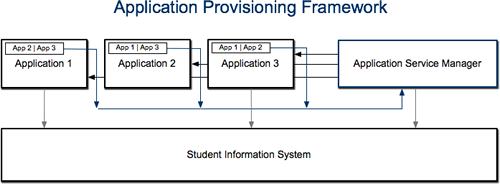Overview
What follows are notes on specifications on the design of the architecture and user interface for this curricular systems interoperability framework.

Developer Interface
The design of this heterogeneous application provisioning architecture should be object oriented and based on open standards for systems interoperability such as the O.K.I.OSID’s . Developers should add connector code to new and existing applications in a connector directory within the source code of the application. This connector directory should contain all the methods the application will use to make connections to other applications. Within the connector directory, there should be sub-directories for each application that the application connects to. These sub-directories should contain methods for mapping relationships between the application and those other applications it connects to such as authentication, authorization, node and module mappings.
If a given application has a theming system or UI that can be customized, the existing UI or themes should be modified (or new themes created) to expose connector functionality to users. Developers should be able to register their connectors so that they appear in a list of "connection" services. Developers may also need to create methods for connection settings.
User Interface
General connection services (e.g. Authentication) that are exposed to the user should appear superordinate to (e.g. above and outside) the application’s UI. Specific connection services (e.g. connections involving authorization and/or node/module mapping) should provide intermediate connection setting interfaces to authenticated users who are authorized to make mappings.
